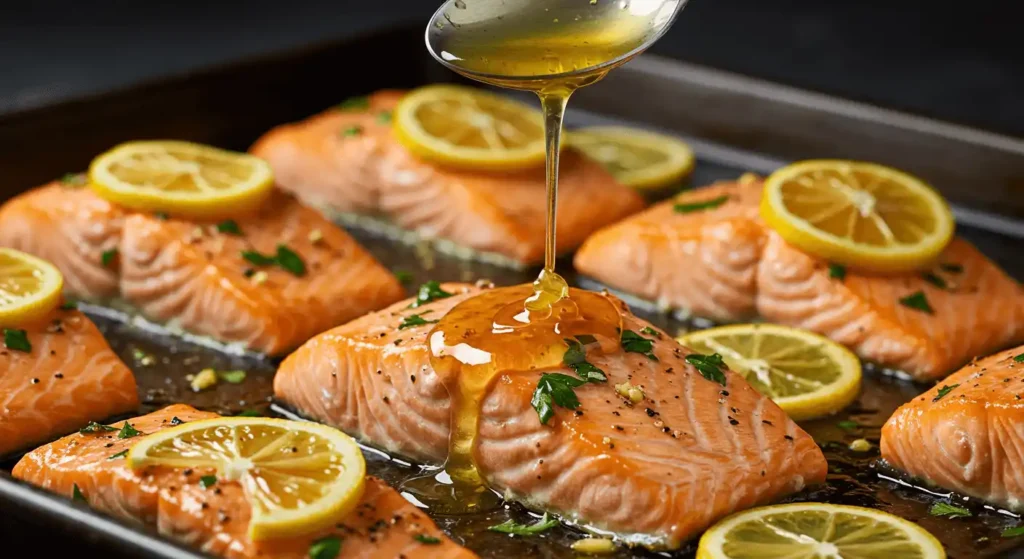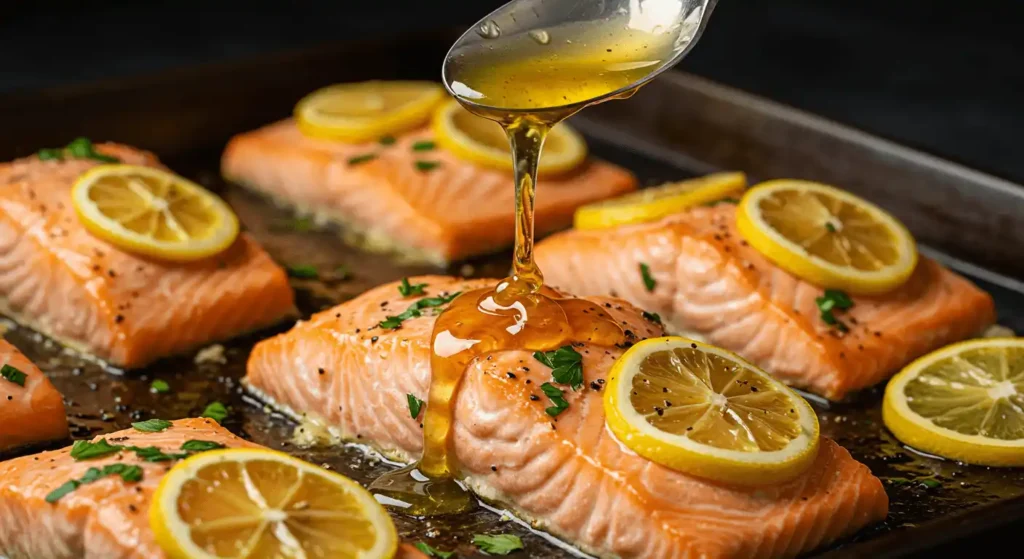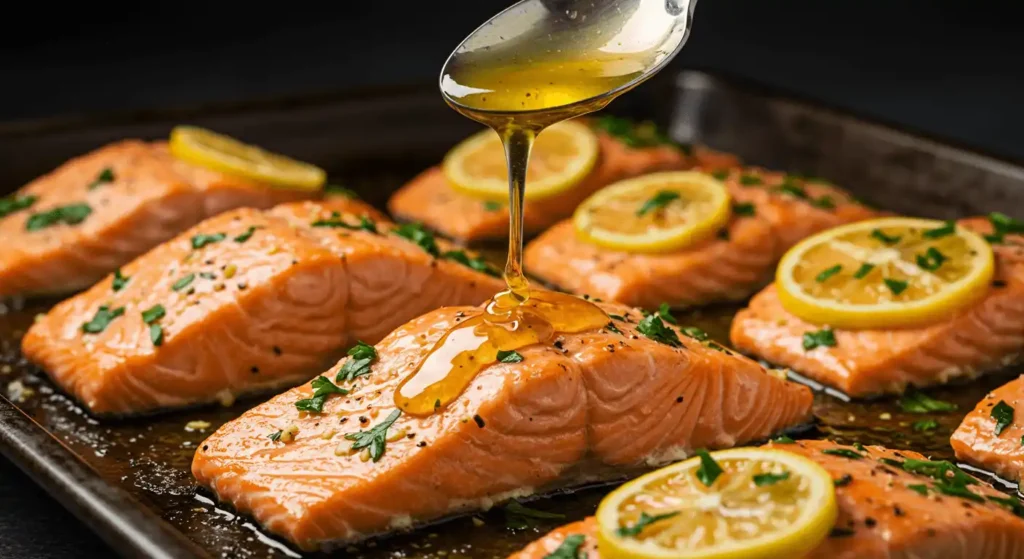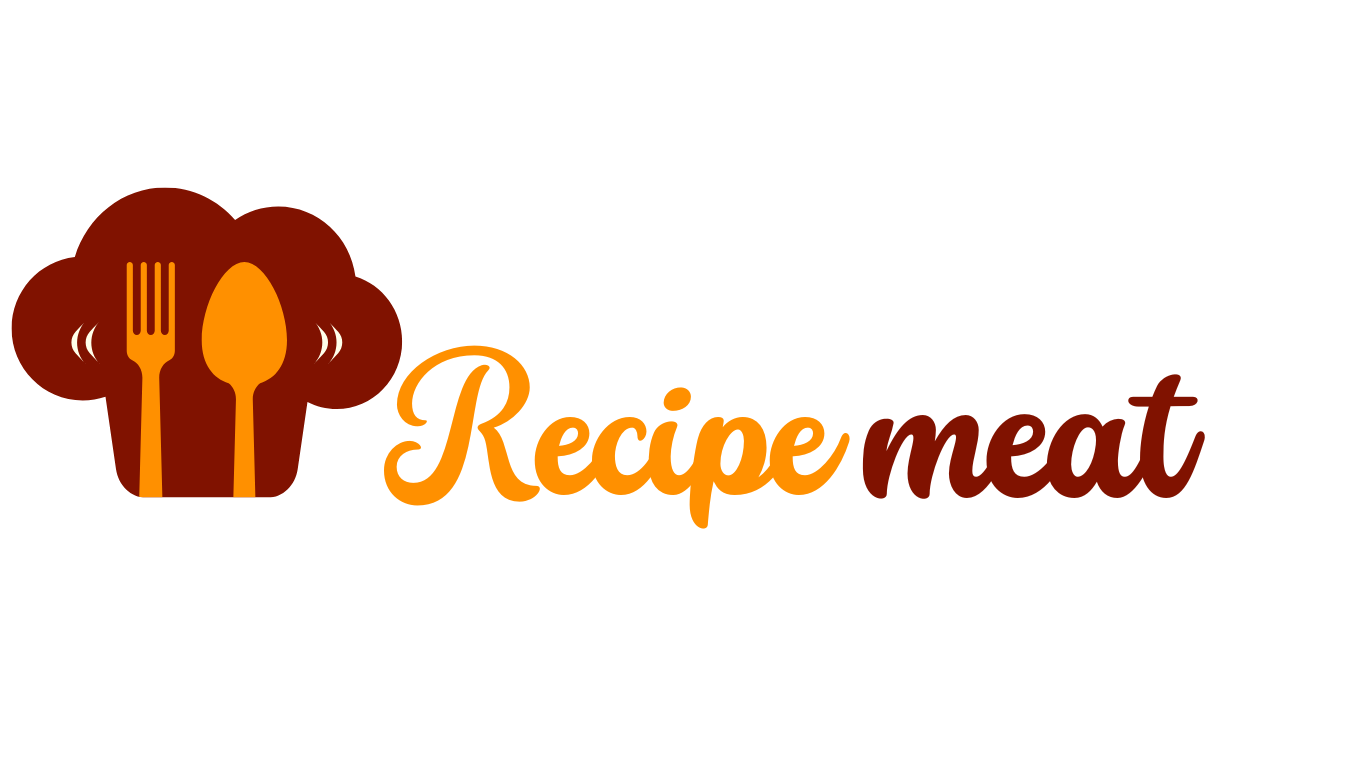Introduction
If you’re looking for a simple and flavorful dinner that’s ready in just 20 minutes, this baked salmon recipe is the one to keep on repeat. Whether you’re cooking for your family or preparing a healthy weeknight meal, this method delivers juicy salmon with minimal effort. All you need is a few pantry staples like garlic, lemon, olive oil, and your favorite salmon fillet.
Baking salmon in the oven is one of the easiest ways to cook it evenly without drying it out. When baked at the right temperature, the salmon cooks to a perfect texture—tender, flaky, and rich with flavor. Even if you’re new to seafood or unsure about how to tell when salmon is done, this guide will walk you through every step clearly.
Whether you’re using fresh or frozen salmon, wild or farmed, this recipe works with any type of salmon. You’ll learn how to bake the salmon properly, how long to cook it, and the best temperature to bring out the natural flavor of the fish.
With this easy baked salmon recipe, there’s no guesswork. It’s baked on a single sheet pan or wrapped in foil for easy cleanup. Serve it with roasted vegetables, a simple salad, or rice, and you’ve got a balanced, satisfying meal in no time.
So if you’ve ever wondered how to make salmon in the oven that comes out juicy, flavorful, and never overcooked—this recipe has you covered.
Table of Contents
Key Benefits
This easy baked salmon recipe is more than just quick—it’s packed with health benefits, practical advantages, and taste you can count on. This is why it’s a go-to favorite for home cooks everywhere:
1. Ready in Just 20 Minutes
With a total bake time of 12–15 minutes, plus a few minutes of prep, this recipe is ideal for busy weeknights. You can have a flavorful, protein-rich dinner on the table faster than takeout.
2. Minimal Ingredients, Maximum Flavor
You only need a handful of kitchen staples—garlic, fresh lemon, olive oil, and salmon fillet. These basic ingredients come together to create a dish that’s light, zesty, and deeply satisfying.
3. Perfectly Juicy and Tender Every Time
Baking the salmon at the best temperature for baking salmon (375°F) ensures it stays moist and never dry. Wrapping it in foil or covering it lightly keeps the heat gentle, locking in natural juices. The result? Perfectly cooked salmon that flakes easily and melts in your mouth.
4. Healthy and Heart-Friendly
Salmon is rich in omega-3 fatty acids, vitamin D, and lean protein. Baking instead of frying keeps it low in fat and calories, making this a smart option for those watching their health or managing specific diets.
5. Easy to Customize
This recipe is incredibly versatile. Whether you’re working with wild salmon or frozen salmon, you can easily adapt it. Add fresh herbs, swap butter for olive oil, or add a splash of lemon juice or spice for variety.
6. No Special Equipment Needed
There’s no need for a grill or fancy pans. All you need is a rimmed baking sheet or a baking dish. You can also wrap the salmon in foil for even easier cleanup.
7. Works With Any Cut
No matter the cut—whole side, fillets, or skin-on portions—this method flexes to suit your salmon perfectly.
8. Foolproof for Beginners
Worried about how to know when salmon is done? We’ll show you simple signs—like how the salmon should flake or turn opaque—that make this method stress-free, even for first-timers.
This combination of speed, taste, and health makes it one of the best go-to recipes for anyone who wants to cook salmon with confidence.

Ingredients
This easy baked salmon recipe keeps things simple while delivering bold flavor. Below is everything you’ll need to make juicy, flavorful salmon in under 20 minutes. These ingredients are commonly found in most kitchens and can be easily adjusted depending on your preferences or the type of salmon you use.
Main Ingredients
- 4 salmon fillets (about 6 oz each, skin on or off depending on preference)
– You can use fresh, frozen, or wild salmon. If using frozen salmon, thaw it in the refrigerator overnight for best results. - 2 tablespoons olive oil
– Adds richness and helps keep the salmon juicy while baking. - 2 tablespoons fresh lemon juice
– Brings brightness and balances the richness of the salmon. - 3 garlic cloves, minced
– Provides bold, savory flavor that complements the fish. - Salt and freshly ground black pepper, to taste
– Essential for seasoning. - 1 teaspoon dried herbs (such as dill, parsley, or thyme)
– Optional, but adds a fragrant finish.
For Garnish (Optional but Recommended)
- Lemon slices
– Place on top of the salmon before baking for visual appeal and extra lemon aroma. - Chopped fresh parsley
– Adds color and a fresh touch before serving. - Butter (1 tablespoon per fillet)
– You can dot the salmon with butter before baking or mix it with garlic for a quick garlic butter drizzle after baking.
Optional for Foil Packet Method
- Aluminum foil or parchment paper
– Ideal for wrapping each salmon fillet to lock in moisture and make cleanup a breeze. - Vegetables (optional)
– Add quick-cooking vegetables like thin-cut zucchini, asparagus, or cherry tomatoes to the foil for a one-packet meal.
💡 Tip: When choosing your cut of salmon, look for firm, bright-colored fillets without a strong fishy smell. This ensures freshness and great flavor.
Now that your ingredients are prepped, let’s move on to making the best baked salmon with step-by-step instructions.
Instructions
Follow these simple steps to bake salmon that’s juicy, flavorful, and cooked just right—whether you’re using fresh or frozen salmon fillets. These directions use the foil method, which helps lock in moisture and flavor, but you can also bake the salmon directly on a rimmed baking sheet.
Step 1: Preheat Your Oven
- Set your oven to 375°F (190°C).
This is the best temperature for baking salmon—hot enough to cook the fish quickly without drying it out.
Step 2: Let the Salmon Come to Room Temperature
- Remove the salmon from the refrigerator about 15 minutes before cooking.
Letting it sit helps the fish cook more evenly. If using frozen salmon, ensure it is fully thawed first.
Step 3: Prepare the Baking Dish or Foil Packets
- You can either:
- Line a baking sheet with parchment paper or foil and lightly oil it, or
- Cut a piece of foil large enough to wrap each fillet individually if using the foil method.
- Line a baking sheet with parchment paper or foil and lightly oil it, or

Step 4: Season the Salmon
- Place the salmon fillets on the prepared sheet or foil (skin side down if skin is on).
- Brush the salmon with olive oil and lemon juice.
- Sprinkle garlic, salt, pepper, and herbs evenly over the top.
- Add lemon slices on top of each fillet for extra aroma and moisture.
Step 5: Optional – Add Butter
- Dot each fillet with a small piece of butter or drizzle with melted garlic butter for richer flavor.
Step 6: Bake the Salmon
- Cover the salmon loosely with foil if baking on a sheet, or seal the foil packets if using the wrap method.
- Place the salmon in the oven and bake for:
- 12 to 15 minutes, depending on the thickness of your salmon.
- A general rule: Bake 4–6 minutes per ½ inch of thickness.
- 12 to 15 minutes, depending on the thickness of your salmon.
💡 Tip: The salmon will continue to cook slightly after it’s removed from the oven, so don’t overbake.
Step 7: Check for Doneness
- The salmon is done baking when:
- The flesh flakes easily with a fork.
- It’s opaque and slightly firm, but not dry.
- Internal temperature reaches 125°F to 130°F (52–54°C) for medium; up to 145°F (63°C) for well-done.
- The flesh flakes easily with a fork.
- You can gently poke the salmon in the thickest part to test—it should flake, not feel rubbery.
Step 8: Remove and Serve
- Remove the salmon from the oven and let it rest for 2–3 minutes.
- Serve warm with your favorite side dishes or over a salad.
✅ No flipping needed: Salmon bakes best skin side down, and turning it over may cause it to fall apart.
- If using frozen salmon, be sure to thaw it safely in the refrigerator overnight.
With these steps, you’ll get perfectly baked salmon that’s juicy, flavorful, and ready in no time.
Pro Tips and Variations
Cooking salmon in the oven is simple, but a few small techniques can make a big difference. These tips help ensure you get the most flavor, best texture, and flexibility from this easy baked salmon recipe.
Pro Tips for Perfect Baked Salmon
Let the salmon come to room temperature
Cold fish straight from the fridge cooks unevenly. Letting the salmon come to room temperature for 15–20 minutes before baking ensures even cooking and better texture.
Use the right temperature
Baking at 375°F gives you the right balance of gentle heat and speed. It helps the salmon cook through without drying out the surface.
Don’t overcook
Salmon is done when the thickest part flakes easily with a fork. The flesh should be opaque but moist. Overcooking leads to dryness and a chalky texture. The internal temperature should be 125–130°F for medium or 145°F if you prefer it fully cooked.
Leave the skin on (if using skin-on fillets)
Baking salmon with the skin side down protects the delicate flesh from direct heat and helps retain moisture. You can easily peel it off after cooking if you prefer not to eat it.
Rest before serving
Letting the salmon sit for 2–3 minutes after baking allows the juices to redistribute. This keeps the fish moist and perfectly cooked.
Wrap in foil for moisture
Baking salmon in foil traps steam, keeping the fillets juicy. It also prevents sticking and simplifies cleanup.
Flavor Variations to Try
This base recipe is flexible and easy to adjust. Try these simple flavor twists to change things up:
Herb-Crusted Baked Salmon
- Mix fresh chopped parsley, dill, and chives with breadcrumbs and a touch of olive oil.
- Press the mixture gently onto the top of the salmon before baking.
Garlic Butter Salmon
- Mix melted butter and lemon juice with minced garlic.
- Pour over the salmon before baking or drizzle on top afterward for a rich, silky finish.
Lemon Pepper Salmon
- Use lemon slices on top and season generously with lemon pepper for a bold citrus-pepper kick.
Honey Mustard Glaze
- Mix 1 tablespoon of Dijon mustard with 1 tablespoon of honey and a bit of olive oil.
- Brush over the salmon before baking for a sweet-savory crust.
Spicy Cajun Salmon
- Rub the salmon with Cajun seasoning or smoked paprika, garlic powder, and cayenne.
- Serve with a squeeze of fresh lemon for balance.
Sheet Pan Salmon Meal
- Surround the salmon with thin-sliced vegetables like zucchini, bell peppers, or asparagus.
- Bake everything together on the same tray for a full meal with no extra dishes.
- 💡 Check that the internal temperature reaches 125–145°F. The FDA recommends at least 145°F for doneness.
Serving Suggestions
This juicy baked salmon is incredibly versatile and pairs well with a variety of sides, sauces, and presentations. Whether you’re putting together a casual dinner or a more refined plate, here are great ways to enjoy your salmon from the oven.

Classic Dinner Pairings
1. Roasted Vegetables
Serve your salmon alongside roasted asparagus, broccoli, zucchini, or carrots. Drizzle with olive oil and season with salt and pepper for a clean, healthy plate.
2. Garlic Mashed Potatoes or Rice
Creamy mashed potatoes balance the brightness of the lemon and garlic salmon. Alternatively, steamed jasmine or basmati rice makes a great base to absorb juices from the baked salmon.
3. Quinoa or Couscous Salad
These light grains pair well with salmon’s richness. Add chopped herbs, tomatoes, cucumbers, and a squeeze of fresh lemon for extra freshness.
4. Mixed Greens Salad
A fresh salad with arugula, baby spinach, or mixed greens tossed in a lemon vinaigrette offers a crisp contrast to the warm salmon. Add feta, olives, or avocado for extra flavor.
Low-Carb or Light Options
1. Cauliflower Rice
A lighter alternative to regular rice, cauliflower rice keeps the dish low-carb while soaking up the garlic-lemon flavor.
2. Steamed or Sautéed Greens
Spinach, kale, or Swiss chard with a touch of garlic pairs well with the salmon with olive oil base.
Add a Sauce or Drizzle
A flavorful sauce can enhance the salmon and make it even more satisfying.
- Garlic butter sauce: Rich and silky, made with butter, garlic, and lemon juice.
- Dill yogurt sauce: A cool, tangy topping made with Greek yogurt, lemon, dill, and salt.
- Simple aioli: Blend mayo, lemon juice, and a little garlic for a creamy finish.
Leftover Salmon Ideas
If you have leftover salmon, don’t let it go to waste. It’s great the next day in:
- Salmon salad: Flake the salmon into a bowl with chopped celery, onion, and mayo or Greek yogurt.
- Salmon tacos: Add flaked salmon to soft tortillas with slaw, avocado, and lime.
- Salmon grain bowls: Use quinoa or rice as a base, and top with leftover salmon, roasted vegetables, and a lemon-tahini dressing.
- Cold salmon pasta salad: Toss chunks of leftover salmon with cooked pasta, cherry tomatoes, spinach, and vinaigrette.
Conclusion
This baked salmon recipe is the kind of meal you’ll find yourself coming back to again and again. It’s fast, easy, and delivers consistently juicy, flavorful salmon in just 20 minutes. Whether you’re cooking for one or feeding a family, the simplicity and flexibility of this dish make it ideal for both quick dinners and special occasions.
By following a few key steps—preheating your oven, using the right seasoning, and knowing how to tell when salmon is done—you can make perfectly cooked salmon without stress. You don’t need to flip it. You don’t need fancy ingredients. Just fresh (or thawed frozen salmon), a few basic items, and a hot oven.
Even if you’ve never baked salmon before, this method makes it easy to succeed. You’ll learn how to make salmon in foil, understand how thickness affects bake time, and discover how small touches like lemon slices on top or a drizzle of garlic butter can take it to the next level.
From healthy weeknight meals to dinner parties, this is the recipe I make most often, and it never disappoints.
FAQs
How do you know when baked salmon is done?
You’ll know your salmon is done cooking when the flesh flakes easily with a fork and turns opaque all the way through. The internal temperature should read 125°F to 130°F (52–54°C) for medium, or up to 145°F (63°C) if you want it well done. You can also gently poke the salmon in the thickest part—if it separates into moist flakes, it’s ready to eat. Avoid overbaking, as the fish will continue to cook slightly after you remove it from the oven.
How long does salmon take in the oven?
The bake time depends on the thickness of your salmon. A standard fillet that’s about 1-inch thick takes 12 to 15 minutes in a preheated oven at 375°F. Thinner pieces may take only 10 minutes, while thicker cuts or a side of salmon may take closer to 18 minutes. A good rule is to bake for 4 to 6 minutes per ½ inch of thickness.
Is it better to bake salmon skin up or down?
Bake salmon skin side down. The salmon skin acts as a natural barrier between the heat and the delicate flesh, helping to keep the fillet moist and preventing it from sticking to the pan or foil. You can remove the skin easily after baking if you prefer not to eat it.
Do you need to flip salmon when baking?
No, you do not need to flip the salmon when baking it in the oven. In fact, flipping can cause the fillet to break apart and lose its moisture. When baked skin side down, the salmon cooks evenly from the bottom up, especially if it’s wrapped in foil or baked in a covered dish.



